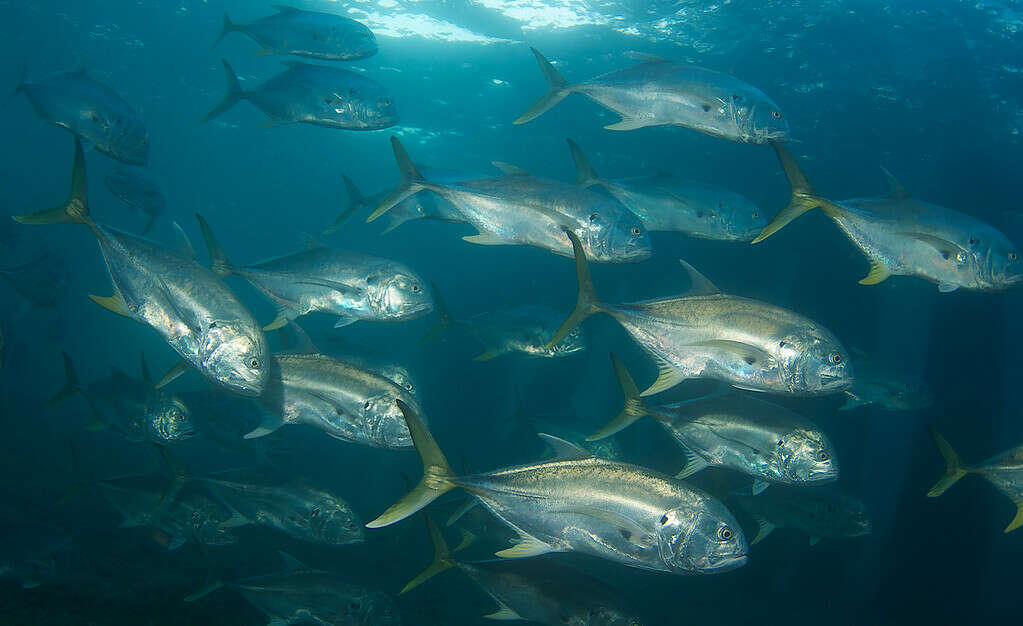Jack Crevalle
Caranx hippos
The jack crevalle is a highly aggressive predator!
Advertisement
Jack Crevalle Scientific Classification
- Kingdom
- Animalia
- Phylum
- Chordata
- Class
- Actinopterygii
- Order
- Carangiformes
- Family
- Carangidae
- Genus
- Caranx
- Scientific Name
- Caranx hippos
Read our Complete Guide to Classification of Animals.
Jack Crevalle Conservation Status
Jack Crevalle Facts
- Main Prey
- Smaller fishes
- Name Of Young
- Fry
- Group Behavior
- Solitary/School
- Fun Fact
- The jack crevalle is a highly aggressive predator!
- Biggest Threat
- Sharks
- Most Distinctive Feature
- Aggressive nature
- Other Name(s)
- Crevalle jack, common jack, blacktailed trevally, couvalli jack, black cavalli, yellow cavalli
- Average Spawn Size
- Up to one million eggs
- Predators
- Sharks, bigger fish like marlins, barracudas, seabirds
- Lifestyle
- Diurnal
- Common Name
- Crevalle jack
- Number Of Species
- 1
- Slogan
- One of the biggest species in the Caranx genus
- Group
- School
- Migratory
- 1
Jack Crevalle Physical Characteristics
- Color
- Blue
- Green
- Silver
- Olive
- Skin Type
- Scales
- Age of Sexual Maturity
- Four to five years (males), five to six years (females)
- Venomous
- No
- Aggression
- High
View all of the Jack Crevalle images!
Jack Crevalle Summary
The jack crevalle is a highly predatory species of marine fish belonging to the genus Caranx. It roams freely throughout the Atlantic Ocean, appearing along the coasts of many adjacent countries. It primarily preys on smaller fish and various invertebrates like crustaceans. Although sport fishers value it as a tough game fish, it is not a popular food fish and has limited commercial value.
5 Jack Crevalle Facts
- One of the largest species in Caranx: This species is one of the largest members of the genus Caranx, weighing as much as 70 pounds and growing up to four feet long.
- Fearless predators: These fish are famous for their ferocious hunting instinct, which makes them valuable game fish.
- Diurnal: This species is diurnal, which means it is mainly active in the daytime.
- Larger individuals may leave their schools: Although most adults of this species move in schools, some choose to go off on their own once they grow large enough.
- Females grow larger than males: Females of this species tend to grow to greater lengths and weigh more than their male counterparts.
Jack Crevalle Classification and Scientific Name
The jack crevalle (Caranx hippos) is a predatory marine fish in the genus Caranx (jacks, trevallies, and pompanos), which contains 18 species. Alternate names for Caranx hippos include crevalle jack, common jack, blacktailed trevally, couvalli jack, black cavalli, and yellow cavalli.
From a broader taxonomic perspective, the jack crevalle is a ray-finned fish (class Actinopterygii) in the order Carangiformes (jacks). It further belongs to the family Carangidae (jacks and pompanos). Carangidae contains 30 genera and at least 148 species.
Jack Crevalle Appearance

Although most adults of this species move in schools, some choose to go off on their own once they grow large enough.
©Jack Leahy/Shutterstock.com
The broad-bodied jack crevalle is among the largest members of its genus. It grows up to four feet in length, though a mature length of one to 2.5 feet is more common. While adults of this species can weigh as little as two pounds, the heaviest specimen on record weighed 70.55 pounds. Females generally grow larger than males.
This species’ distinguishing marks include a steep forehead and dark spots on the gill covers, bases of the pectoral fins, and possibly the lower pectoral rays. The dorsal region ranges from olive to bluish-green in color with brassy or silvery sides. Although scales are present on most of the body, they are absent from the chest and throat.
Jack Crevalle Distribution, Population, and Habitat
The jack crevalle is common in both the eastern and western Atlantic Ocean, including the western Mediterranean. Although there are reports of these fish in the Pacific Ocean, these most likely refer to a related species, the Pacific crevalle jack (Caranx caninus). Similarly, reports of the species in the Indian Ocean are probably sightings of the giant trevally (Caranx ignobilis).
The jack crevalle inhabits waters along the coasts of North America, South America, Europe, and Africa as well as Turkey in Asia. It ranges from Nova Scotia in Canada as far as Uruguay in South America, including the following U.S. states: Maine, New Hampshire, Massachusetts, Rhode Island, Connecticut, New York, New Jersey, Delaware, Maryland, Virginia, North Carolina, South Carolina, Georgia, Florida, Alabama, Mississippi, Louisiana, and Texas.
This species primarily lives in marine environments, though it occasionally enters brackish waters. It is reef-associated and oceanodromous (migratory within salt waters), swimming at depths up to 1,150 feet. Below is a table of the countries, islands, and regions where this fish is found.
| North America | South America | Europe | Africa | Asia |
|---|---|---|---|---|
| Anguilla | Brazil | Albania | Algeria | Turkey |
| Aruba | Colombia | France | Angola | |
| Bahamas | French Guiana | Gibraltar | Benin | |
| Belize | Guyana | Greece | Cameroon | |
| Canada | Suriname | Italy | Canary Islands | |
| Costa Rica | Uruguay | Monaco | Cape Verde | |
| Cuba | Venezuela | Portugal | Congo | |
| Curaçao Island | Spain | Congo (Democratic Republic) | ||
| Dominican Republic | Cote d’Ivoire | |||
| Guatemala | Equatorial Guinea | |||
| Haiti | Gabon | |||
| Honduras | Gambia | |||
| Jamaica | Ghana | |||
| Mexico | Guinea | |||
| Neth Antilles | Guniea-Bissau | |||
| Nicaragua | Liberia | |||
| Panama | Libya | |||
| Puerto Rico | Madeira Islands | |||
| Saint Kitts and Nevis | Mauritania | |||
| Trinidad and Tobago | Morocco | |||
| Turks and Caicos Islands | Nigeria | |||
| United States | São Tomé and Príncipe | |||
| Virgin Islands (UK) | Senegal | |||
| Virgin Islands (US) | Sierra Leone | |||
| Saint Helena | ||||
| Togo | ||||
| Tunisia | ||||
| Western Sahara |
Worldwide populations of this species are currently stable. As of 2018, the IUCN lists the species as Least Concern.
Jack Crevalle Evolution and History
Within the Paleogene Period, the Eocene Epoch (56 to 33.9 million years ago) was a time of emergence for many of today’s perciforms, including members of Caranx. The first fossils from this genus came from the mid-Eocene. As with many fish species, otoliths (ear bones) are the most common type of fossil for Caranx.
Linnaeus first described the jack crevalle in 1766. Its initial scientific name was Scomber hippos. This later became Caranx hippos after naturalist Bernard Germain de Lacépède created the genus Caranx. The species was known by a variety of different names throughout its history, including Caranx carangua and Caranx hippos caninus, which have since fallen out of favor.
Scientists have debated whether or not to consider the jack crevalle (Caranx hippos) the same species as the Pacific crevalle jack (Caranx caninus) from the eastern Pacific. This debate also extends to a relatively new species, the longfin crevalle jack (Caranx fischeri) from the eastern Atlantic. These three species are part of the crevalle jack complex and are morphologically similar with dark marks on their pectoral fins and opercules, similar scale patterns on their breasts, and enlarged canines in their lower jaws. However, the general consensus is that these remain separate species due in part to variations in hyperostosis and anal fin colors.
Jack Crevalle Predators and Prey
Jack crevalle are highly predatory carnivores that do most of their hunting in the daytime. However, their frequent proximity to the surface makes them vulnerable to certain other predators.
What Do Jack Crevalle Eat?
These fish prey mostly on smaller fish like mackerel, mullet, anchovies, and pinfish. They also eat invertebrates like crustaceans (including shrimps, prawns, and crabs) and mollusks (including some cephalopods like squid). Juveniles mainly eat small fish and crustaceans.
What Eats Jack Crevalle?
Despite being fearless predators, these fish frequently fall prey to other marine fish like sharks, marlins, and barracudas. Juveniles are the targets of any fish larger than themselves as well as hunting seabirds, which pick them off near the surface of the water.
Jack Crevalle Reproduction and Lifespan
The jack crevalle is iteroparous, reproducing several times throughout its life. It is also oviparous, laying eggs that hatch outside its body. Spawning usually occurs year-round with specified periods in some regions. For example, the typical spawning period in Florida is early March to early September. In Ghana, however, peak spawning occurs between October and January.
Prior to spawning, these fish form large schools and either move offshore or inshore to bays and reefs. Sexually mature pairs break off from the main school, whereupon the female lays her eggs. The male then fertilizes them. The eggs are pelagic, remaining in open water until they hatch. The larvae stay in the same area until they reach the juvenile stage. At this point, they head to brackish estuaries or lagoons. They return to the ocean when they are sufficiently mature. Although larger individuals may be solitary, most adults remain in fast-moving schools.
Males attain sexual maturity between four and five years of age while females become mature at five or six years of age. Females may produce as many as one million eggs. Additionally, fish of this species can live as long as 19 years.
Jack Crevalle in Fishing and Cooking
The jack crevalle is a popular game fish for its size and fighting spirit. When caught, these fish may emit croaking or grunting noises. They tend to bite hard and fight harder, so be prepared for a struggle when attempting to reel one in. Both live and artificial lures have met with success.
Despite its popularity among sport fishers, this species does not make the best food fish. It tends to be fishy and oily and is best suited for bait. However, it is still edible and may make a decent meal if carefully prepared. Check out this article for advice on how to prepare and cook jack crevalle.
View all 36 animals that start with JJack Crevalle FAQs (Frequently Asked Questions)
Where is the Jack Crevalle found?
These fish inhabit the eastern and western Atlantic Ocean along the coasts of North America, South America, Europe, Africa, and Asia.
Is the Jack Crevalle good to eat?
While this species is edible, it is not generally considered a valuable food fish.
Are Jack Crevalle aggressive?
These fish are aggressive, powerful hunters that have earned the respect of sport fishers for their fighting spirit.
Is the Jack Crevalle an endangered species?
This species is not currently endangered. As of 2018, the IUCN lists it as Least Concern.
Thank you for reading! Have some feedback for us? Contact the AZ Animals editorial team.
Sources
- , Available here: https://www.fishbase.se/summary/71
- , Available here: https://www.iucnredlist.org/species/190458/86346358
- , Available here: https://www.fishbase.se/summary/FamilySummary.php?ID=314
- , Available here: https://digitalcommons.odu.edu/biology_fac_pubs/68/
- , Available here: https://tpwd.texas.gov/huntwild/wild/species/crjack/#:~:text=The%20average%20size%20in%20Texas,near%20structure%20in%20the%20bays
- , Available here: https://www.floridamuseum.ufl.edu/discover-fish/species-profiles/caranx-hippos/#:~:text=Caranx%20hippos%20was%20first%20described,name%20is%20still%20in%20use.
- , Available here: https://saltwatermecca.com/what-do-jack-crevalle-eat/
- , Available here: https://www.realtree.com/timber-2-table-wild-game-recipes/are-jack-crevalle-fish-worth-cooking
- , Available here: https://eol.org/pages/46577967
















